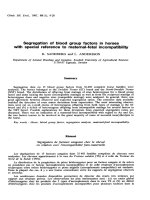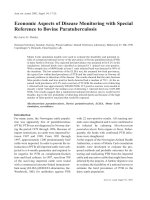A sociological study of tamil entrepreneurship with special reference to up country tamil business in sri lanka
Bạn đang xem bản rút gọn của tài liệu. Xem và tải ngay bản đầy đủ của tài liệu tại đây (3.66 MB, 252 trang )
1
A SOCIOLOGICAL STUDY OF TAMIL
ENTREPRENEURSHIP WITH SPECIAL REFERENCE TO
UP-COUNTRY TAMIL BUSINESS
IN SRI LANKA
SARATH ANANDA
B.A. (Hons) Peradeniya, M Phil (HUST) Wuhan
A THESIS SUBMITED FOR THE DEGREE OF DOCTOR
OF PHILOSOPHY
DEPARTMENT OF SOCIOLOGY
NATIONAL UNIVERSITY OF SINGAPORE
2011
2
A SOCIOLOGICAL STUDY OF TAMIL
NTREPRENEURSHIP WITH SPECIAL REFERENCE TO
UP-COUNTRY TAMIL BUSINESSIN SRI LANKA
SARATH ANANDA
NATIONAL UNIVERSITY OF SINGAPORE
2011
I
ACKNOWLEDGEMENTS
The submission of a PhD thesis is undoubtedly one of the greatest moments in the
life of an academic. It is also a very sensitive occasion once it is earned after
facing numerous challenges. I share the same feelings at the moment. Since this is
not an outcome of a single day or single month, a lengthy list of people comes to
my mind as stakeholders of this effort during the four-year study period.
First of all I am grateful to the Singapore government for offering me an
opportunity to read for my doctoral degree at the NUS; and to my teachers Prof.
K.T. Silva and Prof. Amarasiri de Silva who shared their valuable time to
recommend me for this PhD programme. Dr. Ms. Samarakoon, the former Dean
of Arts and Social Sciences is also memorable as one of the atypical kind-hearted
personalities at the Sabaragamuwa University. I will never forget Prof. Gamini
Samaranayake, Chairman of the University Grants Committee who helped me
defend many issues that came from the university administration. My cherished
colleagues Mr. Aruna Shantha, Mr. Niroshan Vithanage, Ms. Shanthi Hemalatha,
and Mr. Sampath Fernando, Athula Samarakoon and Miss Kalpani come to mind
as gracious friends in this adventure. I also offer my gratitude to Ravi, Sunethra,
and Ranjula all Sabaragamuwa University staffers for their cooperation in various
ways. The academic support received from Prof. S.K. Pinnawala was also another
significant turning point of this process.
My previous Supervisory Committee members; Prof. Jennifer Jarman, Prof.
Joonmo Son, Prof. Rajesh Rai should also be kept at the frontline of this thank
giving list for spending their time to guide me towards considerable destinations
in this arduous academic journey. Especially, Prof. Jennifer showed so much
kindness towards me by addressing defensive points during difficult times.
Prof. Petrovic Miodrag (Misha) my supervisor, I am particularly indebted to him for
his outstanding subject knowledge, friendly cooperation and accountability in this
process. I would never have been able to finish this work if I had not met him as a
teacher during my study period.
My colleagues as well as friends, Susantha, Chandima, Dushyanthan, Mr. Shiva
and Miss. Nuwanthi played significant roles as helpers at the stage of independent
data collecting. Their knowledge on research methodology and different areas of
research field and personal contact with interviewees enabled me into collecting
valuable data. Moreover, Dr. Nageshwaran, the Head of the Department of
Languages of Sabaragamuwa University of Sri Lanka and Prof. Chandrasekaran,
Dean of the Faculty of Education of University of Colombo enhanced my
knowledge on Up-country Tamil community as the central spaces of my academic
social network unfolded.
Ms. Nandani & Pandmini are memorable in providing network relations to
overcome accommodation facilities in the research field. Mr. Madugalla (The
Secretary of Nuwaraeliya Urban Council) & Mr. Ranathunge (Secretary of the
Hatton Urban Council) are also outstanding officials and friends who helped me
II
officially and unofficially. Mr. Rusiri and Mr. Nishantha helped me as sureties
during my hard times of processing university agreement procedures.
The staff members of Peradeniya University Library, SUSL Library, Sathyodaya
& ICES library in Kandy are remarkable for their services. Especially Ms.
Niranjala, Ajantha, Kanchana, and Mr. Alwis are noteworthy among the
acquaintances of those libraries.
Further, my greater gratitude should go for my NUS teachers in sociology: Prof.
Micheal Hill, Prof. Erb Marybeth, Prof. Chee Kiong Dong, Prof. Jean Yeung Wei-
Jun, Prof. Chua Beng Huat, and CELC teachers Mr. Jeganathan, Miss. Soon-Fen,
Mr. Patrick Gallow and Dr. Chitra who were crucial in widening my knowledge in
sociology and the English language.
I have to particularly mention here and offer my gratefulness for the kind and
amicable assistance of Mrs. Raja & Miss Shirley who made it easy to resolve so
many difficulties of NUS life. Some NUS friends like Shahoo, Zaiful, Keith,
Minushree, Stephanie, Omar and other strong network members like Lalith, Ransi,
Rev. Pathmasiri, Rev. Gunasiri, Rev. Dhammasiri, Jayathilaka, Pubudu & Amil
are remembered here as companions who restored to health my heart which was
broken regularly by homesickness. Friends I met at the hostel: Mrinal, Kwadew,
Manav, Alex, Rajiv, Waqas, Rameez and many others are memorable for their
general and academic support. I also must thank several individuals such as Mr.
Yaw, Mr. Ranjith Wijekoon, and Mr. Mustafa Shabbir for their cooperative
support given to me to breach my lousy English writing.
I am also grateful to my wife Inoka and the two young daughters, Maleena and
Amarna for their various sacrifices and facing many challenges during my absence
as husband and a dad for a lengthy period.
Finally, I would like to dedicate my thesis towards the Up-country Tamil workers
who have been shedding their blood, tears and sweat to fertilize our lands for
almost two centuries.
III
TABLE OF CONTENTS
ACKNOWLEDGEMENTS I
TABLE OF CONTENTS III
ABSTRACT VI
LIST OF TABLE VII
LIST OF CHART VIII
LIST OF GRAPHS IX
LIST OF MAPS X
LIST OF ABBREVIATIONS XI
1.1. Introduction 1
1.2. Significance of Study 5
1.3. Theoretical Significance 8
1.4. Policy Significance 11
1.5. Research Objectives 13
1.6. Chapters Outline 14
1.7. Summary 17
Chapter II 19
2.1 Theoretical Framework 19
2.2 Defining Entrepreneurship 20
2.3 Mainstream and Outsider Entrepreneurship 21
2.3. Social Capital in Networking Ability and Entrepreneurship 26
2.4. Bonding and Bridging 31
2.5. The Function of Market 40
2.6. Summary 42
Chapter III 44
3. Methodology 44
3.1. Research Field 44
Nuwara Eliya 45
Badulla 46
Hatton 46
3.2 Target, Study Unit and Sampling 47
3.3 Data Collection Techniques 48
3.3.1 Interviewing 48
3.3.2 Sociogram-sociometric 49
3.3.3 Focus-group Discussions 51
IV
3.3.4. Observations 53
3.4. Limitations and the solutions at each step 54
3.5. Summary 57
Chapter IV 59
4. Macro Level Outlook of Tamil Entrepreneurship 59
4.1. Introduction 59
4.1.2. The Tamil Diaspora 61
4.2.1. NattuKottai Chettiars: An Icon of the Entrepreneurial Great Tradition 67
4.2.2. Chettiars‟ Business in Sri Lanka 70
4.2.3. End of Chetti era in Sri Lanka 75
4.2.4 Chettiars‟ Business in Singapore and Malaysia 78
4.2.5. Chettiars‟ Business in [Burma] Myanmar 80
4.3.1. Muslim-Tamils: Legacy of Tamil and Arabian Business Traditions 82
4.3.2. Tamil-Muslim Identity in Sri Lanka 83
4.3.3. Muslim-Tamil Trade in Singapore and Malaysia 85
4.4.1. Sri Lankan Tamil Business 86
4.4.2. Sri Lankan Tamil Business in US, Europe and other Continents 87
4.4.3. Sri Lankan Tamil (Jaffna Tamil) Business in Malaysia 90
4.5. Summary 95
Chapter V 96
5. Origin of Up-country Tamil Business in Sri Lanka 96
5.1.1. Introduction 96
5.1.2 Up-land Tamils, Plantation Tamils, Indian-origin Tamils in Sri Lanka or “Malaiyaka
Tamil” Community 97
5.2. A Brief History of Up-country Tamil Community 99
5.2.2. Push Factors of Indian Labour in Sri Lanka 101
5.3. Social ties of Up-country Tamil community 105
5.3.1. Religion 105
5.3.2. Kinship 108
5.3.3. Politics 109
5.5. Caste as a promoting factor towards class 113
5.5.2. Caste as a stimulating factor towards trade 117
5.4. Kanganies and Kanakkupullais: the top of the bottom 120
5.4.2. Rise of Kanganis 123
5.4.3. Capital Accumulation by Kanganies 127
5.5.3. The Bottom Line of Up-country Tamil Entrepreneurship 129
5.6. Summary 136
Chapter VI 138
6. Networking among Up-country Tamil Business 138
6.1 Trends of Business 138
V
6.2. Reciprocity in Business Networks 140
6.3. Networking Patterns of Up-country Tamil Businesses 151
6.4. Summary 180
Chapter VII 182
7. Anthropology of Entrepreneurial behaviour of Up-country Tamil Community 182
7.1. Gender and Entrepreneurship 183
6.2. Savings Patterns 189
7.2.1. Seettu: The Banking of Bottom Line 194
7.3. Business Loans and Attitude towards Borrowing 197
7.4. Attitude towards Business 199
7.5. Businessman-Customer Behaviour 202
7.6. Summary 208
Chapter VIII 209
Conclusions 209
References: 218
Appendix I 235
Outline of Focus Group Discussions and Interviewing of Business Owners 235
Codes 237
Appendix II 238
Appendix III 239
VI
ABSTRACT
This study attempts to construct a broad discourse on particular characteristics of
Tamil entrepreneurship with special reference to the Up-country Tamil community
in Sri Lanka. It illustrates the nature of the Up-country Tamil business identity
within the broader framework of Tamil ethnic entrepreneurship by providing a
review of literature about the legacy of Tamil entrepreneurship, and using primary
data collected from field research in the central highlands of Sri Lanka. Since the
usual literature on ethnic entrepreneurship has emphasized internal and external
contact, socio-cultural profile, and historical backdrop of reputed entrepreneurial
communities, this attempt may be a different experience that emphasizes business
approaches of a causally non-significant entrepreneurial group. Therefore, this
thesis demonstrates, the Up-country Tamils are significant as creators of the
entrepreneurial „little tradition‟ among other Tamil market makers such as the
Nattukottai Chettiars and the Tamil Muslims.
The valuating reciprocity between different network relations, revealing the
accumulating patterns of micro-scale fiscal and social capital, ethnographic
exploration of the positive and negative effects of socio-cultural factors of the
research community take significance in constructing a theoretical argument
illustrating two strands of business approaches, i.e. the great and little tradition
within a single ethnic group. It is also important in comprehending how far a
marginal social group has succeeded in building their initial entrepreneurship needs
through bonding relations within the community and expanding the networking
capacity towards external contacts (bridging). Further, the study tries to understand
the entire market system as a purposive action. Broadly, the study intends that these
insights form an in-depth view on the nature of entrepreneurial behaviour of the
bottom line, and these findings will be helpful in enhancing the social and economic
status of marginal communities.
Key Words: ethnic entrepreneurship, Tamil business networks, Up-country
Tamils in Sri Lanka
VII
LIST OF TABLE
Table: 4.1 Chettiar Firms of Sri Lanka in 1930s 74
Table 4.2 Remittances sent by Chettiars from Sri Lanka to India 76
Table 5.1 South Indian Districts from which the Immigrant Labour was drawn for
the plantations in Sri Lanka, 1905-20 103
Table 5.2 Growth of Indian Tamil Estate Population in Ceylon 104
Table 5.3 Religious composition of the Up-country Tamils- 1981 106
Table 5.4 The Percentage Distribution of the Castes of the Immigrants, 1905-20 113
Table 5.5 Proportion in workforce on caste identity 115
Table 5.6 A selected list of Head and sub kanganies 126
Table 6.1 Random Sample of Up-country Tamil Business in Nuwara Eliya,
Badulla and Hatton 139
Table 6.2 Descriptive significance of personal relationship in each business
function 143
Table 6.3 The Levels of the Significance of reciprocity 149
Table 7.1 Risks and Profits analysis of Migrant Women to the Middle East 188
VIII
LIST OF CHART
Chart 6.1 Overall summary of the weightage of business relationships 141
IX
LIST OF GRAPHS
Graph 6.1 160
Graph 6.2 165
Graph 6.3 167
Graph 6.4 169
Graph 6.5 170
Graph 6.6 173
Graph 6.7 174
Graph 6.8 176
Graph 6.9 177
Graph 7.1 192
X
LIST OF MAPS
The Location of Research Field 45
XI
LIST OF ABBREVIATIONS
AD Anno Domini
BC Before Christ
BWTP Banking With Poor
CBC Central Bank of Ceylon
CE Common Era
CELC Centre for English Language Communication
CIC Ceylon Indian Congress
CLC Ceylon Labour Commission
CWC Ceylon Workers Congress
DCS Department of Census and Statistics
GCE General Certificate Education
ICES International Centre for Ethnic Studies
IEGs Informal Economic Groups
INGOs International Non Governmental Organisations
JEDB Janatha (Peoples‟) Estate Development Board
LTTE Liberation Tigers of Tamil Elam
MAs Managerial Agents
MFEW Migrant Foreign Employed Women
NGOs Non Governmental Organizations
NUS National University of Singapore
OPEC Organization for Petroleum Exporting Countries
PPC Paraih, Pallar & Chakkiliar
RPC Regional Plantation Companies
SLFP Sri Lanka Freedom Party
SLSPC Sri Lanka Estate Plantation Companies
TCC Tamil Chamber of Comerce
UNP United National Party
UREBS United Railway Employment Benefits Society
1
Chapter I
1.1. Introduction
Tamil entrepreneurship has played a considerable role in the current global market
economy. This is directly related to the global dissemination of the Tamil Diaspora
as a result of various historical and socio-economic developments, which have
affected the Tamil community on the Indian subcontinent and the Northern areas of
Sri Lanka. Historically, the development of naval technology and seafaring culture
could be identified as main factors for the expansion of Tamil trade. Colonialism
accelerated this circumstance. Some internal factors such as social customs, values
and networking patterns have also been remarkably useful for particular Tamil
groups to enhance their entrepreneurial skills. Likewise, the Up-country Tamil
1
business community in Sri Lanka has also built a significant identity which has
constructed their entrepreneurial network as a marginalized enclave (Hollup 1994).
Therefore, this thesis focuses on the entrepreneurial dynamics of the Tamils as an
ethnic group with special attention to the Tamil community of Indian origin (read:
Up-country Tamils) of Sri Lanka.
1
The Up-country Tamils are mainly descendants of the workers‟ community who migrated from
South India to Sri Lanka in the 19
th
and 20
th
centuries to work in colonial coffee, tea and rubber
plantations. Some migrated later as merchants and traders. Initially they were recruited mostly by the
British planters in tea and coffee estates of Sri Lanka‟s central highland areas such as Badulla,
Nuwara Eliya, Kandy, Matale and Rathnapura. According to the census of 2001, 855,888 people
were listed as „Indian Tamils‟; out of which 695,705 were living on estates (Frasch, et al. 2006: 44).
Some writers like Sahadevan (1995: 88) suggest that the estimated population of the Up-country
Tamils should be much higher than the official statistics noted in the census as over 200,000 persons
had acquired citizenship by descent since 1948 and had since declared themselves as „Sri Lankan
Tamils‟. Whilst many of the early migrants did come to work in the plantation economy initiated
under British rule, some other Tamil migrants were employed in the late 19
th
century expansion of
the Colombo Harbour and for the construction of Ceylon‟s roads and railways (ibid). The 2001
census estimates that 50,190 Indian Tamils come under the category of „urban‟ population and
109,993 Indian Tamils are part of the rural populations mostly residing in the estates (ibid).
Instrumental in maintaining the plantation economy of Sri Lanka, they are commonly termed as
Tamils today, but some have Telungu and Malayalee origins as well.
2
Different factors ranging from the historical to the political-economic background
along with cultural factors are responsible for building ethnic entrepreneurial
identity. Since a large collection of academic writings on ethnic entrepreneurship
have emphasized the above particular characteristics pertinent to the mainstream
entrepreneurial groups, this thesis seeks to present a differentiated experience by
focusing on the entrepreneurial identity of the Up-Country Tamils as an „outsider
entrepreneurial community‟. Structural factors such as caste-kinship networks, the
traditional heritage of human capital and excessive self-exploitation capacity tend to
be the initial essence of the Up-country Tamil business patterns in Sri Lanka. By
means of long-term literature collection and field research, this thesis sketches out
an ethnographic and qualitative outline on the entrepreneurial structure of the Up-
country Tamil community in contrast to the other Tamil entrepreneurial groups of
Sri Lanka and worldwide.
The key outcomes of this study may be important in comprehending how far a
marginalized social group has succeeded in building their initial entrepreneurship
needs through relations within the community and expanding their networking
capacity through the external contacts. The strategies they adopted for the
achievement of their entrepreneurial goals illustrate typical characteristics.
Accumulation of initial fiscal and social capital by an excluded group outside the
reputed business circles seems to be different from the mainstream entrepreneurial
communities that obtain the necessary support from their established economic
structures.
3
Thus, the current study focuses on building a sociological discourse on the Up-
country Tamil community as a minority and marginalized entrepreneurial group by
understanding their distinctive characteristics in terms of gathering information,
consulting services, personal aid and loans, supplying manual labour, and many
other resources obtained via traditional social networks. These factors may be
important in taking a broad view on the nature of the Up-country Tamil
entrepreneurship vis-à-vis the other Tamil entrepreneurial groups of Sri Lanka.
Variations in Tamil business approaches of an assortment of Tamil communities in
different regions of the world reflect the multiple models of socio-economic and
geographical characteristics of each location and community (Weerasooriya 1973;
Rudner 1989 & 1994; Hollup 1994; Arokiaswamy 2000). For instance, some groups
such as the Nattukottai Chettiars and Tamil-Muslims are structurally an inherent
part of the business environment they reside in, while others like the Kanganies and
manual labourers who emigrated overseas have developed their entrepreneurial
skills in relation to the socio-economic conditions of their new context.
Moreover, some groups who represent similar “ethnic enclaves” have settled as
traders in the USA, Europe and some Scandinavian countries as a result of modern
globalization and human flows. „Tamil entrepreneurship‟ can be classified as both
mainstream or a „great tradition‟ and outsider or „little tradition‟ entrepreneurs.
2
Usually the groups who have been traditionally branded as the business groups or
2
Great tradition & little tradition both concepts were being used by prominent anthropologist
Robert Redfield in his studies of peasant societies of Mexico which belonged to great Mayan
Civilization. He argues that when elites maintain the great traditional culture, literature, technology
or many other things, the peasants became responsible to preserve the same obsessions in their
own manner equivalent to the relevant circumstance (see Wilcox 2006).
4
“entrepreneurs” easily move with upward mobility channels. Such groups possess
material and non-material capital. In this sense, there is a significant hierarchy
among Tamils regarding the prevelance of entrepreneurship. This study will argue
that some entrepreneurs like Chettiars and Tamil-Muslims as representatives of the
mainstream Tamil entrepreneurial identity (Mahroof, 1976; Chattopadyaya, 1979;
McPherson 2010). Kanganies and middle-class overseas-immigrant Tamils
characterize the overlap of great tradition and outsider business conventions.
However, it is the business owners who are derived from the workers community
like Up-country Tamils in Sri Lanka, Malaysia, South Africa, and Mauritius belong
to the outsider or „little tradition‟ of entrepreneurs. As such, it is necessary to have a
broader assessment of socio-economic and historical features of Tamils in terms of
scrutinizing the variances of their entrepreneurial characteristics.
By studying the networks, social ties and bridging through caste, kinship, marriage,
neighbourhoods, and friendship it would be important to understand the peculiar
nature of the Up-country Tamil business. In addition to the primordial social
factors, there are significant trends of entrepreneurship that have emerged amongst
the Up-country Tamil community as a result of their reaction to the internal and
external social burdens and opportunities. For instance, the influence of traditional
social values, impact of current global economic trends, the political motive to build
their own identity among other ethnic groups, economic cooperation extended by
governmental and non-governmental organizations, reaction to unemployment or
underemployment, and loss of social security within the plantation economy due to
various structural adjustment policies seem to be the leading factors. Therefore,
some cases of ethnographic materials extracted from field study will be given in
5
analytical parts of the thesis to depict the nature of baseline networks of the Up-
country Tamil business.
1.2. Significance of Study
Societies that possess individuals who are willing and eager to perform
entrepreneurial roles can enhance their growth and development process by moving
forward at a faster pace while those societies lacking these necessary components
lag behind (Akhoury 1997: 37). Therefore, the idea “why would some societies
have such people and others do not” has been the focal point of economic
developmental discourse for several decades in the recent past. When
„entrepreneurship‟ is linked to the adjective „ethnic‟, it focuses attention on a
specific direction. It tries to emphasize „ethnic identities‟ of innovation, trust and
risk which are the major components of entrepreneurship. This entrepreneurial
apparatus reflects an ethnic group‟s access to opportunities, the characteristics of
grouping and emergence of organized strategy.
The available literature on entrepreneurial ethnic groups tends to focus on aspects
such as their geographical expansion, inherent cultural heritage, social ties and
bridging, historical evolution and networking enhancements through embedded
contextual relations (Hoselitz 1951; Supple 1957; Hirschmeier 1964; Jiang 1968;
Kilby 1973; Thambiah 1971; Cobas and Deollos 1989; Mosse, 1987; Aldrich and
Valdinger 1990; Hofstede 1994; Volery and Mensik 1997; Teo 1997; Tong et al.
1998; Min and Bozorgmehr 2000; Lee & Dawes 2005; Schif 2005; Park 2006;
Wen-Yau 2008). These attempts that rely on hypothesizing ethnic entrepreneurship
have been successful in some aspects whilst some are yet to be developed. Such
6
efforts have originated by the opening up of new dimensions in the study of ethnic
entrepreneurship. For instance, according to these studies, some social groups
express higher proclivity to entrepreneurial behaviour than the others. Sometimes
this phenomenon could be observed in a specific enclave within the communities
who reside in the same geographical location. To give a very macro level example,
societies in Europe that were exposed to the modern scientific revolution (read:
Renaissance) are said to be more successful in terms of industrial development than
the agricultural communities that are traditionally bound to their heritage lands in
the regions of Asia, Africa or Latin America These views claim that predominant
factors such as cultural heritage, territorial roots that are grounded by the traditional
units, primordial ties and boundaries such as image of a linear clan, values and
myths determine the ethnic identity of a society.
Unitary ideology of a community could be determined by social relations that have
emanated from kinship, neighbourhood and commonality of language, religious
belief and customs with those that are eventually based on personal attraction,
tactical necessity, and common interest or acquired moral obligation (Shils 1957,
Geets 1963, Rex 1986a; 1986b; 1996; 1997). These concepts have opened newer
trajectories in the study of social entrepreneurship. According to Yinger, “An ethnic
group is a segment of larger society whose members are thought, by themselves or
others, to have a common origin and to share important segment of common culture
and who, in addition, participate in shared activities in which the common origin
and culture are significant ingredients” (Yinger 1994: 3). The researcher who is
interested in „ethnic entrepreneurship‟ has to ascertain these ethnic identities, and
relate these to the risk, trust and innovation that are identified as major
7
entrepreneurial characteristics. The reaction to the concurrent social reality by a
relevant social group is an important aspect in terms of demonstrating the social
identity of entrepreneurship (Nagata 1974; Epstain 1978).
Some have even argued that ethnic identity could be developed as a class reaction
(Bonacich 1980), interest based action (Glazer & Moynihan 1975), or it could be
directed towards gaining access to political or economic resources. Particularly this
discourse carries a powerful argument on how far culture and policy factors are
effective in terms of entrepreneurship development in a community. Accordingly,
these ideas create a literary environment to comprehend Tamil entrepreneurship as
well. It seems that the entire discourse has been constructed using the ingredients of
those so-called “mainstream entrepreneurial” groups. Moreover these attempts are
likely to be mere efforts at generalizing the current achievements that had been
acquired by each community.
Studying the nature of entrepreneurial skills of a community, which portrays lesser-
heard characteristics of being members of a minority, marginal and immigrant
group would be slightly different. Of particular concern to this study, is the strategy
used by Up-country Tamil community and how it differs from the mainstream
entrepreneurial communities. The Up-country Tamils accumulate micro-scale social
capital using relations embedded within their community and successfully construct
a „proper business space‟ utilizing accumulated human capital in the second stage.
To scrutinise the formulation of this impressive mechanism operating within the
Up-country Tamil Community of Sri Lanka is the main stimulus of this study.
8
1.3. Theoretical Significance
This thesis inspects in depth, the historical background of entrepreneurship studies
and related theoretical perspectives. Further, it scrutinises the historical background
that reflects the ethnic identity of Tamil community, their cultural ingredients such
as customs, norms and values, and their ability to keep pace with contemporary
socio-economic changes in Sri Lanka. Therefore, the current thesis is focused on the
multiple factors that are responsible in constructing their entrepreneurial identity. In
view of the above factors, caste and kinship-based networking system, excessive
self-exploitation, and push factors related to social marginalization derived from
everyday challenges can be taken as the key characteristics, which make up their
entrepreneurial identity. The wider theoretical interest of these characteristics relies
on its contribution to the development of the concept, „marginal entrepreneurship‟
within the broader discussions of ethnic entrepreneurship.
Aldrich et al. developed a framework for understanding the correlation between two
variables: ethnicity and entrepreneurship. Their approach explains ethnic enterprise
using a framework based on three dimensions: (1) an ethnic group‟s access to
opportunities, (2) the characteristic of the group, and (3) emergent strategies
(Aldrich et al. 1990: 114). Components of the opportunity structure characterize
market conditions with easy accessibility to ethnic products or services, favourable
opportunities within inter-ethnic competition for vacancies, and government policy.
When market conditions are favourable, migrants and other minorities can access
the opportunity channels more easily. Most commonly there is the possibility of
these opportunities being hampered by non-ethnic group members, and government
intervention is important in providing legal security (ibid). Group characteristics are
9
created as a result of common settlements, homogenous cultural activities and
common historic experiences as an ethnically marginal community.
Aldrich et al. also emphasize the strategies that are generated from the reciprocity
between opportunity structures and group characteristics (ibid: 130). They highlight
at-least four approaches used by ethnic businesses: (1) self-exploitation (2)
expanding the business by moving forward or backward in the chain of production,
or by operating other shops, (3) funding and supporting ethnic trading associations,
and (4) cementing alliances with other families through marriages (ibid: 131).
Therefore, the approach of Aldrich is important in formulating a conceptual
framework of the relationship between ethnicity and entrepreneurship.
Moreover, migrant and minority entrepreneurship is an important factor in the
relationship between ethnicity and entrepreneurship. Certain ethnic and racial
groups have shown their tendency to be involved in businesses in comparison to
other groups. This ethnic-entrepreneurship dialogue raises a query on how a
particular ethnic or social group is identified as a mainstream entrepreneur and what
the fundamental factors are that constitute it. According to Aldrich et al. (1990)
there are two conditions that affect ethnic groups when attempting to gain access to
the ownership of business: (1) the level of inter-ethnic competition for jobs and
businesses, and (2) governmental policies, which are considerably diverse among
traditional, colonial, nation-building and modern nation states (ibid: 117). The
competition for resources is the nature of human beings and the limitation of
resources seems to augment the situation.
10
Competition to obtain jobs and business opportunities are a common occurrence
between inter-ethnic groups. Under competitive situations, the immigrant or ethnic
minority concerned is likely to lose. To explain such circumstances of direct inter-
ethnic competition over business, researchers have come up with two methods: (1)
highly competitive ethnic groups could be promoted to concentrate in a limited
range of industries, and (2) people could be forced to look for further lucrative
businesses through an interstitial line or they could be pushed out of business
altogether at a very high level of competition (ibid: 118).
Therefore, the people who accumulate economic resources (money, land, labour,
technology) and build remarkable network relations are considered entrepreneurs in
general. They represent the mainstream entrepreneurs who are accountable for
accumulating great wealth from the existing status-quo and economic structure. A
large collection of academic writings on ethnic entrepreneurship emphasizes the
structural characteristics that are suitable for networking potentialities. The
structural opportunities for innovative skills and cultural legitimacy in terms of
wealth accumulation are taken into account when studying mainstream
entrepreneurs. These entrepreneurs are able to accumulate necessary cultural and
social capital from the society.
Within this broader context, multiple factors such as socio-economic opportunities,
cultural and political features that historically affected the Up-country Tamils
should be inspected when exploring their entrepreneurial backdrop. The current
study will cast a new gaze upon entrepreneurialism of „outsider‟ entrepreneurs
rather than focusing on entrepreneurship of mainstream business groups. In this
11
sense, the study will be important in contributing to new knowledge to the pre-
existing corpus of social network studies on ethnic-entrepreneurship among
marginal groups.
1.4. Policy Significance
In terms of the policy implications, this study will be important in several aspects.
The „idea of potentiality of positive linkages between entrepreneurship and
economic prosperity‟; and „the possibility of the development of individual
entrepreneurial capacity through planned efforts are the main stimuli or the guiding
principles of the study. In particular, these hypothetical perspectives and their
experimental paradigms have become increasingly important at different types of
developmental projects in key policy institutions ranging from the World Bank, the
International Monetary Fund, and the Asian Development Bank. These institutions
have successfully consolidated the push factors towards encouraging
entrepreneurship through planned strategies leading to the sustainability of rural and
low-income sectors in the developing world.
In sum, the study is an attempt to understand generally, how a marginal social group
overcomes its socio-cultural barriers by resorting to entrepreneurship; it will also
examine the cultural structure of the Up-country Tamil community, their everyday
needs, and the relations between members of the group in achieving their goals.
Therefore, the study would be useful to policy makers for the purposes of
understanding the socio-economic well-being not only of up-country Tamils in Sri
Lanka but also for the well-being of other marginal and minority groups in similar
contexts.
12
There is much evidence of social revitalization programmes, which have proved to
be unsuccessful due to the inability of members of a particular society to perform
entrepreneurial roles. The main cause of this failure is the lack of in-depth
understanding amongst development practitioners and policy makers regarding
internal mechanism of their target groups. With this particular reflection in mind,
this study will help to deepen the sociological knowledge on minority and marginal
entrepreneurship and their distinctive characteristics in terms of gathering
information, consulting services, aid, personal loan, manual labouring support, and
other resources within their social network. The study will also be important in
understanding minority, marginal and immigrant social groups in terms of how they
build the initial stages of entrepreneurship through the bonding relations within the
community and how this networking capacity is later expanded towards external
contacts. Moreover the understanding of entrepreneurial characteristics of a
particular community simultaneously creates a separate discourse regarding non-
entrepreneurs who exist in the same socio-cultural milieu. Hence the instructive
knowledge produced from this study will directly be useful for development
practitioners who are seeking appropriate approaches to accomplish their goals.
Moreover it will provide measures to policy makers to offer supportive action to the
Up-land Tamil entrepreneurs and similar disadvantaged groups to overcome their
socio-political obstacles that make upward mobility a possibility through the
entrepreneurial actions available to them.









